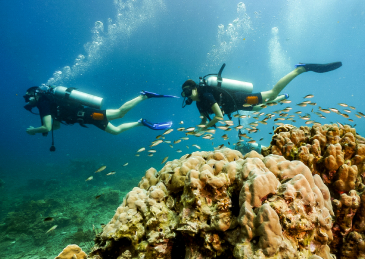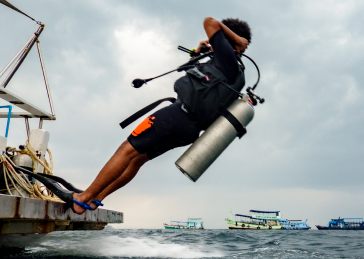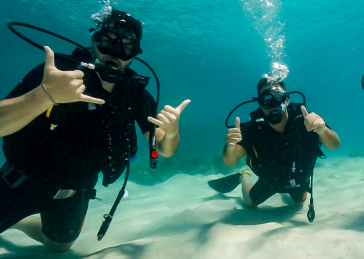Modified 13th June 2025
Stingrays Koh Tao: Your Complete Guide to Three Amazing Species
The waters surrounding Koh Tao’s rich marine heritage provide perfect conditions for stingray populations to thrive. These graceful creatures represent some of the most sought-after encounters for both novice and experienced divers visiting Thailand’s diving capital.
Understanding where and when to find these magnificent animals enhances your diving experience and contributes to marine conservation efforts that protect their habitats for future generations.
Overview of Stingrays Koh Tao Species
Most frequently encountered stingray species, easily recognized by bright blue spots on yellow body. Perfect for underwater photography and beginner encounters.
Larger species typically found resting near wrecks and rocky formations. Distinguished by impressive size and characteristic whip-like tail.
Magnificent diamond-shaped rays that provide unforgettable encounters. Spotted eagle rays offer once-in-a-lifetime sightings for fortunate divers.
Blue-Spotted Ribbontail Ray: The Stars of Koh Tao
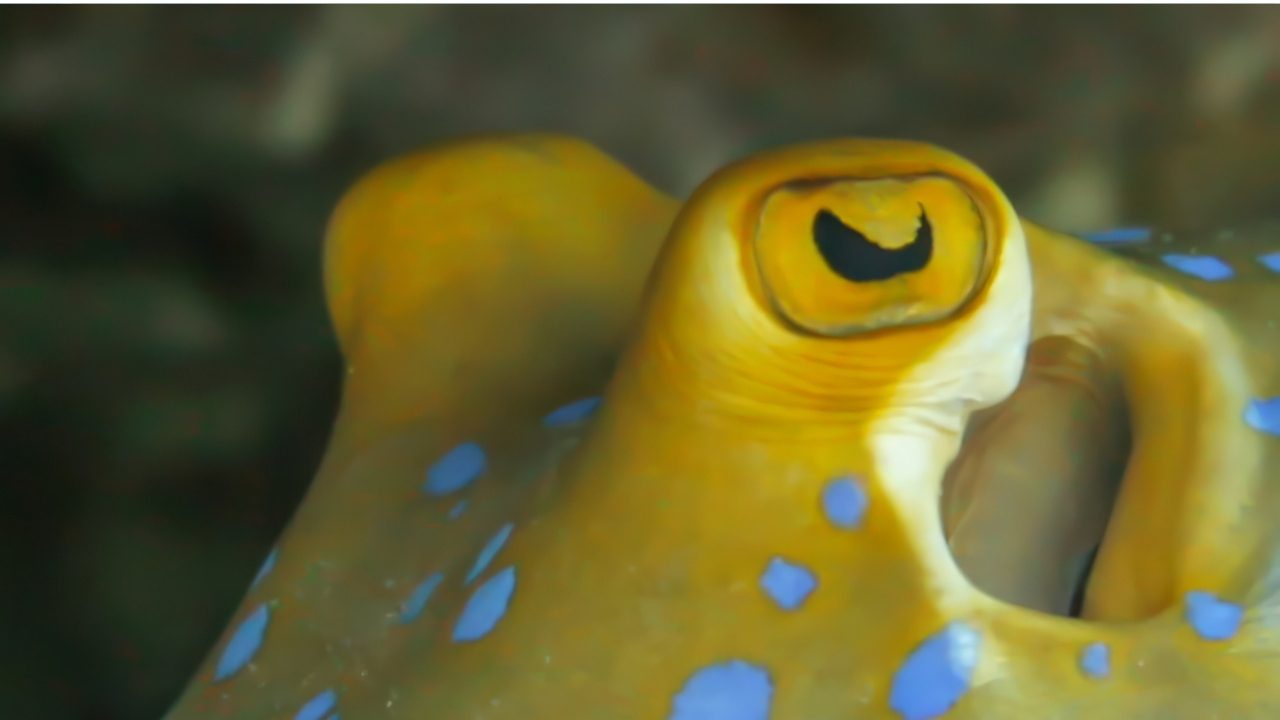
Blue-spotted ribbontail rays represent the most accessible stingray encounters for divers exploring Koh Tao’s diverse marine life. These beautiful creatures inhabit virtually every dive site around the island, making them perfect subjects for underwater photography and marine life observation.
Distinctive Features and Identification
| Feature | Blue-Spotted Ribbontail | Jenkins’ Whip Ray | Eagle Ray |
|---|---|---|---|
| Body Color | Yellow with blue spots | Gray to brown | Dark with white spots |
| Size Range | 20-35cm wingspan | Up to 1.5m wingspan | 2m+ wingspan |
| Tail Length | Body length + 50% | 2x body length | Long with venomous barb |
| Habitat Preference | Sandy areas, coral gardens | Rocky crevices, wrecks | Open water, drop-offs |
| Encounter Frequency | Daily sightings | 2-3 times per week | Monthly or less |
Behavior and Feeding Patterns
Blue-spotted ribbontail rays exhibit fascinating feeding behaviors that make them particularly interesting to observe. These rays use their flattened bodies to uncover small crustaceans, worms, and mollusks hidden in sandy substrates. Their ability to completely bury themselves in sand serves both as camouflage from predators and an ambush strategy for capturing prey.
During optimal diving conditions, these rays become more active, particularly during early morning and late afternoon feeding periods.
Jenkins’ Whip Ray: The Gentle Giants
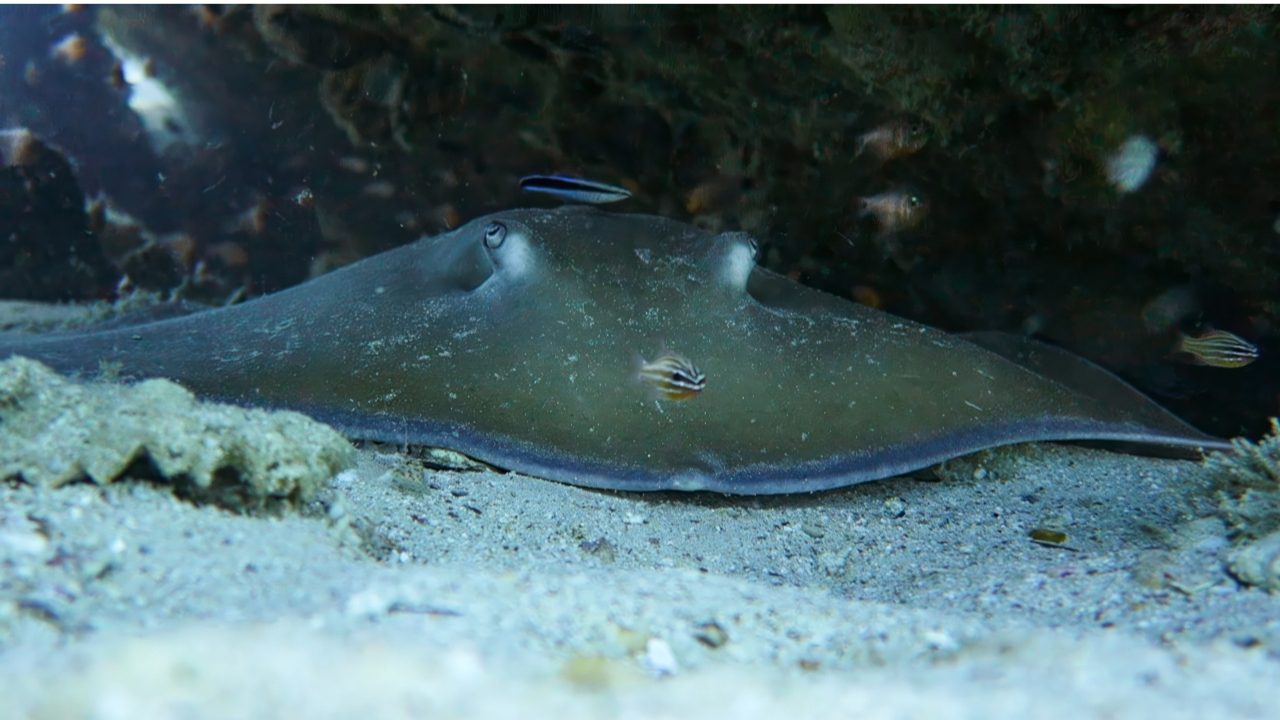
Jenkins’ whip rays offer more challenging encounters for divers seeking unique experiences among the stingrays Koh Tao waters provide. These impressive creatures prefer deeper waters and specific habitat types, making successful sightings particularly rewarding for experienced divers.
Prime Jenkins’ Whip Ray Locations
Based on consistent sighting reports and local dive guide experience, these sites offer the highest probability of Jenkins’ whip ray encounters:
These locations provide the sandy substrates and protective structures that Jenkins’ whip rays prefer for resting and hunting. Check areas near the base of rock formations and around wreck structures where these rays commonly seek shelter.
Size and Physical Characteristics
Jenkins’ whip rays distinguish themselves through their impressive size, with wingspans reaching up to 1.5 meters, making them one of the largest ray species regularly encountered in Koh Tao’s premier dive sites. Their characteristic whip-like tails can extend twice their body length, creating a dramatic silhouette against the ocean floor.
Unlike their colorful blue-spotted cousins, Jenkins’ whip rays display more subdued gray to brown coloration that provides excellent camouflage against rocky and sandy environments. This natural camouflage makes spotting them a rewarding challenge for observant divers.
Eagle Ray: The Crown Jewel Encounter
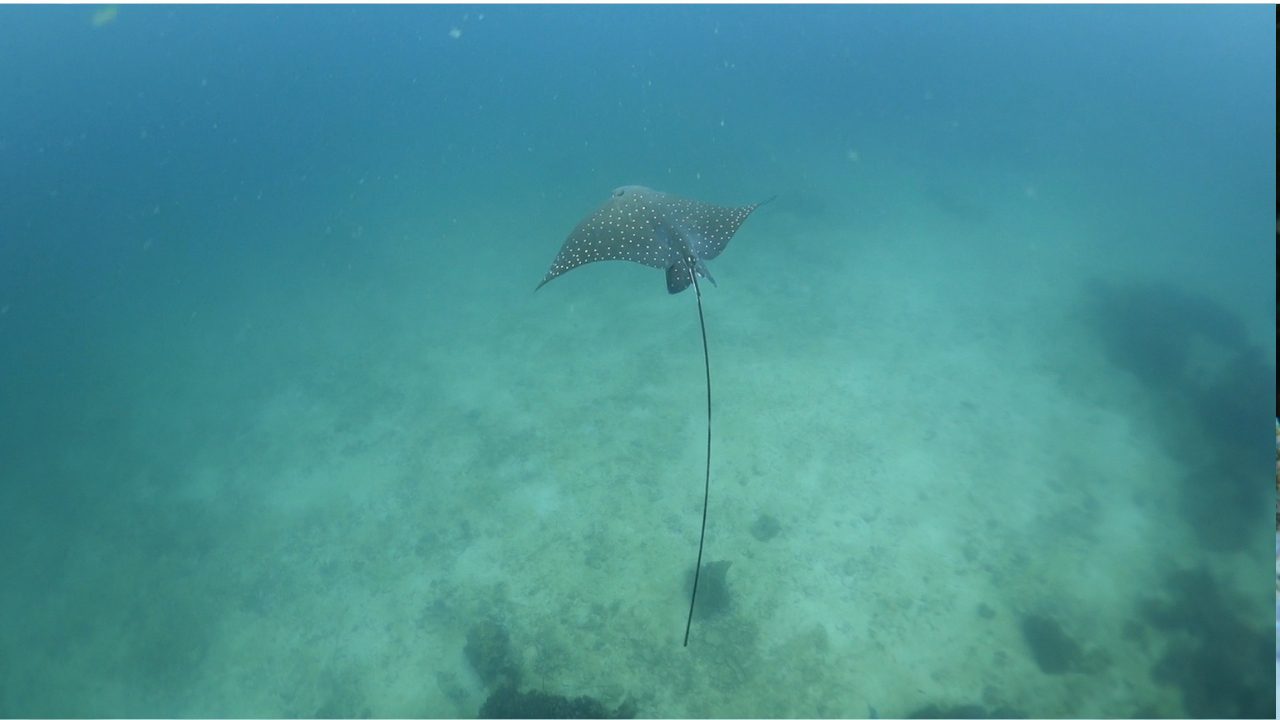
Eagle ray sightings represent the pinnacle of stingray encounters in Koh Tao waters. The Aetobatus ocellatus, or Ocellated Eagle Ray, provides unforgettable experiences for divers fortunate enough to witness their graceful movements through open water environments.
Identification and Unique Features
Eagle rays showcase distinctive diamond-shaped bodies with elongated, pointed wings that create their characteristic “flying” appearance underwater. Their dark bodies adorned with white spots create striking visual contrast that makes identification unmistakable, even from considerable distances.
These magnificent creatures possess long, thin tails equipped with venomous barbs used exclusively for defense. Their graceful swimming style resembles underwater flight, with slow, powerful wing beats that propel them effortlessly through the water column.
Preferred Habitats and Sighting Opportunities
Eagle rays favor deeper waters and open ocean environments, making encounters most likely at sites like White Rock and Shark Island. These locations provide the depth and open-water characteristics that appeal to eagle rays’ migratory nature and feeding preferences.
Conservation and Responsible Viewing
All stingray species in Koh Tao face pressure from habitat degradation and human interference. Responsible diving practices help ensure these magnificent creatures continue thriving in local waters:
- Maintain respectful distances – Never approach closer than 3 meters to avoid stressing animals
- Avoid touching or chasing – Physical contact can damage protective mucus layers
- Support local conservation initiatives – Participate in reef cleanup activities
- Choose eco-conscious dive operators – Select companies committed to sustainable practices
- Practice excellent buoyancy control – Prevent accidental contact with rays or their habitats
While stingrays are generally docile creatures, understanding proper safety protocols ensures enjoyable encounters for both divers and marine life. Never attempt to touch or handle stingrays, as this can trigger defensive responses. Maintain calm, slow movements and allow rays to approach on their own terms. Most stingray “incidents” result from accidental contact or perceived threats, making respectful observation the safest approach for everyone involved.
Seasonal Patterns and Timing
Understanding seasonal patterns enhances your chances of successful stingray encounters. While these species remain present year-round, certain conditions optimize sighting opportunities and interaction quality.
The dry season months provide optimal visibility for stingray observation, with calmer seas allowing better access to deeper sites where Jenkins’ whip rays and eagle rays typically reside. However, planning your visit requires understanding transportation options to Koh Tao during different seasons.
Blue-spotted ribbontail rays maintain consistent presence across all seasons, making them reliable subjects for underwater photography and marine life observation regardless of visit timing. Their adaptability to various conditions ensures encounters at virtually any time of year.
Ready to encounter these magnificent stingrays in their natural habitat?
La Bombona Diving offers expert-guided experiences to Koh Tao’s best stingray encounters. Our experienced divemasters know exactly where and when to find each species, maximizing your chances for unforgettable underwater encounters.
- Expert local knowledge of stingray hotspots
- Small group sizes for better wildlife encounters
- Professional underwater photography opportunities
- Marine conservation education included
- Flexible scheduling around marine life activity
- All skill levels welcome with proper guidance
Fun Diving Package: ฿2,000 – 2 dives to premium stingray sites
Book Your Stingray AdventurePerfect for certified divers seeking exceptional marine life encounters
Preguntas frecuentes
Bucea con LBD: tu puerta a la exploración submarina
Whether you’re a curious beginner or a seasoned pro, our school is your portal to the wonders of scuba diving. Join us into the world beneath the waves.
¿LISTO PARA EMPEZAR?
Consulta nuestros cursos de buceo en Koh Tao
